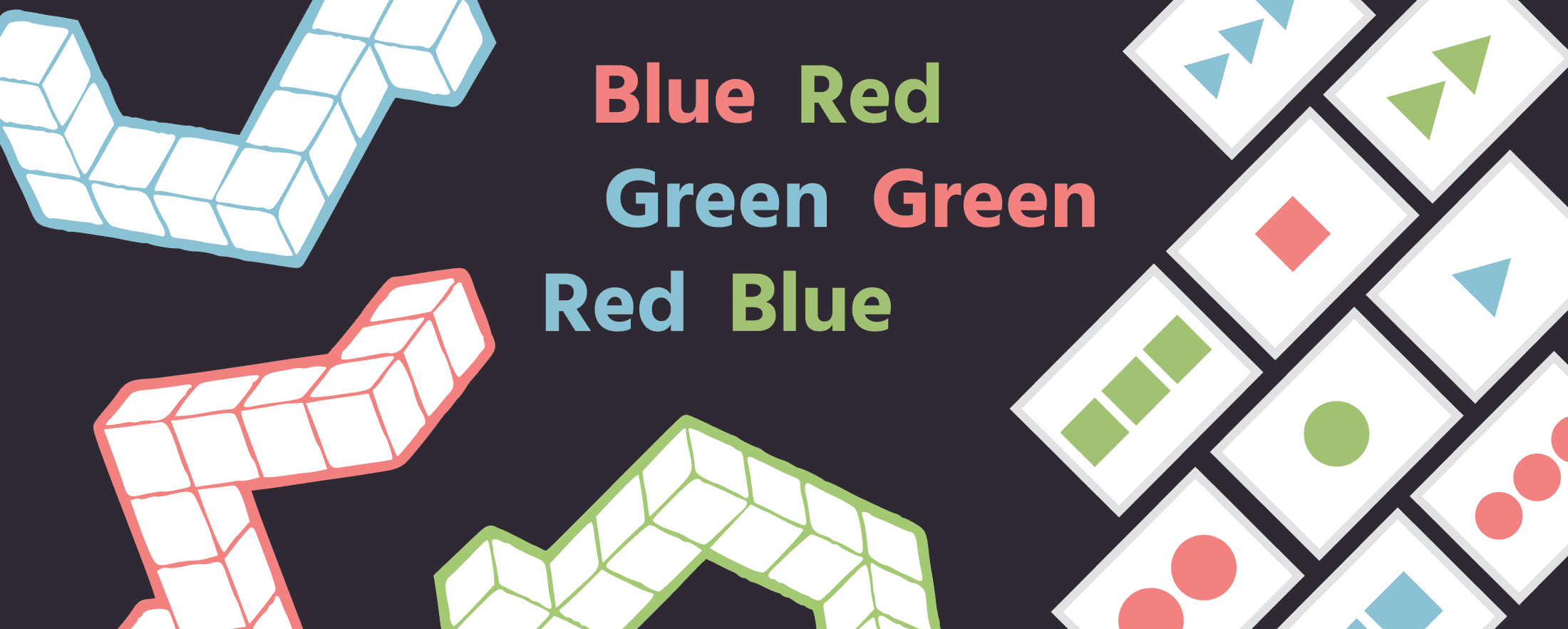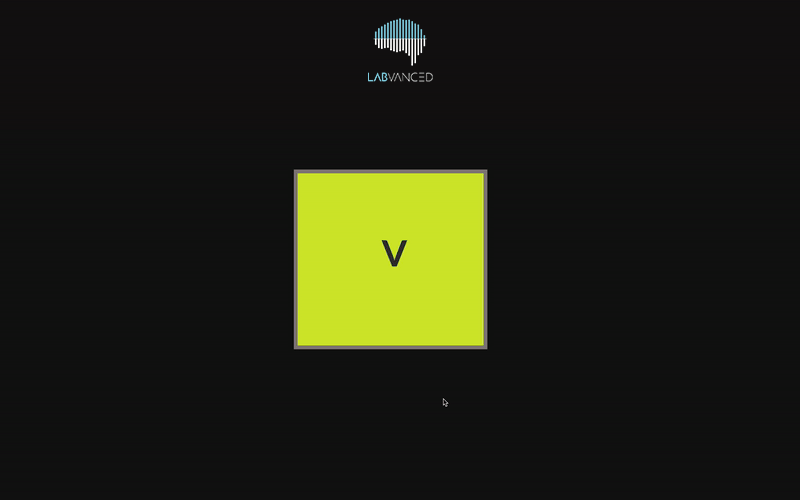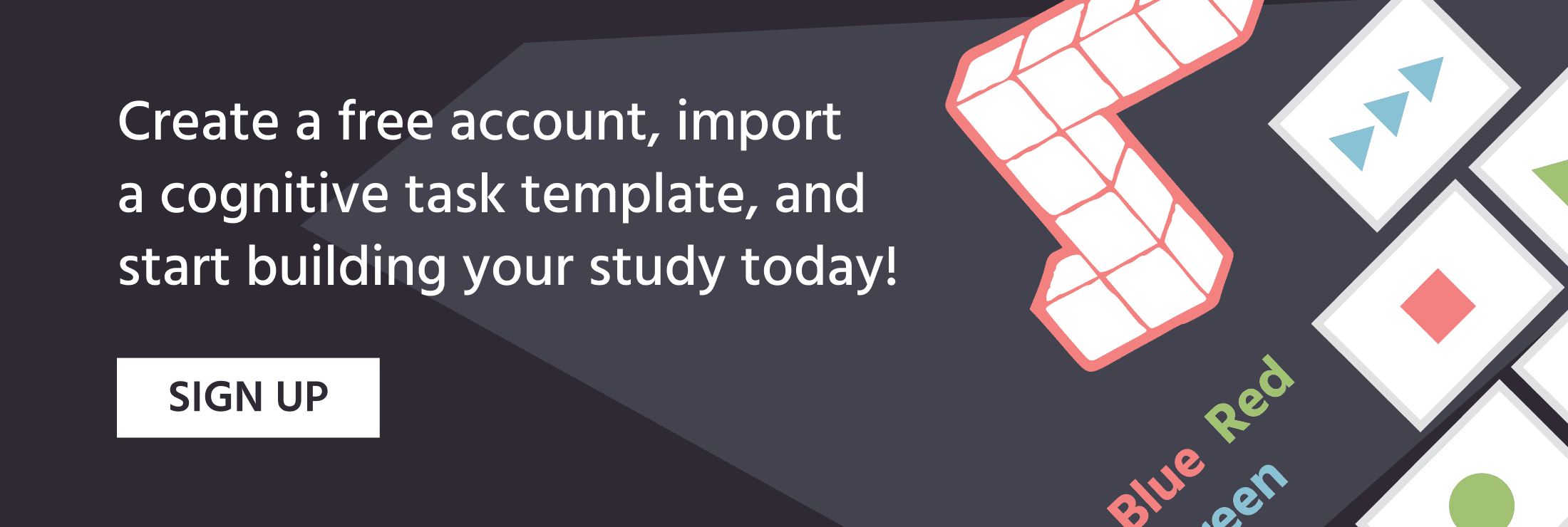
7 Classic Cognitive Tasks
Let’s go over a few key cognitive tasks that are classic examples and commonly used in the domain of cognitive psychology research!
1. Stroop Task
- Overview: Captures the phenomenon where there is a delay in reaction time when stimuli are incongruent as opposed to congruent, ie. the stimuli present conflicting information. The Stroop task is one of the most well known tasks in cognitive psychology.
- Task setup: In the classic set up, a word is presented but you have to report the color of the word, not what the word says. For example, the written word may be blue but its color may be yellow and you have to report yellow as the correct answer. The longer it takes to give a right answer, the stronger the Stroop effect.
- Labvanced experiment: https://www.labvanced.com/player.html?id=2866

- Variations: Commonly used variations of this cognitive task include the: Emotional Stroop, Numerical Stroop, and the Spatial Stroop tasks.
- Processes measured: processing speed, selective attention, automaticity, parallel distributed processing, inhibition, executive control, inhibition, and working memory .
- Also used to study cognitive development. Research has shown that reaction time significantly decreases from early childhood to early adulthood which suggests that the relevant cognitive processes, such as working memory, behind it are developing.
- Origin: Officially coined after John Ridley Stroop who published in 1935. The original paper is one of the most widely cited papers in experimental psychology!
2. Flanker Task
- Overview: This cognitive psychology task is essentially a test of visual perception and attention to a stimulus in the presence of other distractors.
- Task setup: Participants must respond to the direction that a central arrow is pointing, regardless of the direction that nearby arrows are pointing. When the arrows are pointing in the same direction, they are ‘congruent’ but when the target arrow is pointing in a different direction then it is ‘incongruent’ and reaction time is expected to increase.
- Labvanced experiment: This cognitive task example is a modified version of the Flanker Task where the arrows are on different locations of the screen: https://www.labvanced.com/player.html?id=27061

- Variations: Sometimes other stimuli are used, such as objects. In Flanker Tasks for children, more attractive stimuli can be used in order to keep this cognitive task interesting and engaging.
- Processes measured: spatial cognition, visual perception, selective attention, inhibition, executive functions
- Origin: The task was first published in 1974 and is named after the American psychologists Barbara. A. Eriksen & Charles W. Eriksen.
3. Mental Rotation 2D / 3D
- Overview: A powerful, yet simple, cognitive task for assessing spatial processing and abilities.
- Task set up: The participant is presented with a criterion / target object (some shape composed of 3D cubes) and the participant must decide which two options (from the four presented) match the target object. Learn more about the MRT.
- Labvanced experiment:
- 2D Mental Rotation: https://www.labvanced.com/page/library/27147
- 3D Mental Rotation - Cubes: https://www.labvanced.com/page/library/39199

- Variations: Instead of 2D or 3D cubes, different stimuli are used like hands, objects, and non-letter symbols.
- Processes measured: organization, spatial skills like reasoning and cognition, visual perception, intelligence
- Origin: The origins of the MRT date back to 1971 where researchers Shepard and Metzler presented 3D objects at different rotations while rotating it around a vertical axis.
4. Wisconsin Card Sorting Test (WCST)
- Overview: Participants must investigate and quickly adapt to the changing rules of the task through deduction, in order to select the correct card based on the feedback that is presented after each card selection.
- Task setup: A criterion card is shown representing the unsaid ‘rule’ and the participant has to guess which other card (from the options presented) follows the criterion card’s rule. These cards all vary based on shape, number of shapes on it, and the color of the shapes. Read more about the WCST.
- Labvanced experiment: Get a feel of the WCST with this cognitive task example in Labvanced: https://www.labvanced.com/player.html?id=2854

- Processes measured: executive functioning, task switching, cognitive reasoning, cognitive flexibility, working memory, problem solving ability, and response maintenance
- Origin: The WCST dates back to 1948 when researcher Esta Berg wrote the paper A Simple Objective Technique for Measuring Flexibility in Thinking.
5. N-Back Task (2-Back Task)
- Overview: Well-known cognitive psychology task that is also used in clinical and experimental psychology for studying working memory.
- Task set up: A sequence of stimuli is presented and the participant must indicate when the current stimulus is a match for one from n steps shown earlier in the sequence. For example if you see a stream of letters, such as A...F…G…F…, in a 2-back task, you would have to indicate the second ‘F’ is a match because another F appeared two letters before.
- Labvanced experiment: In this N-back task, you will see a stream of letters. Your task is to respond if the letter you see matches the letter you saw 2 steps before: https://www.labvanced.com/player.html?id=35500

- Variations: To make the task more or less difficult, the load factor n can be adjusted. Processes measured: attention, working memory, working memory capacity, concentration, fluid intelligence
- Origin: Wayne Kirchner introduced the n-back task in 1958.
6. Navon Task
- Overview: A task that uses letters to test global and local features of perception based on Gestalt principles.
- Task setup: Participants must focus their attention on individual letters and shapes made up of smaller letters. For example a large ‘H’ composed of smaller ‘H’ letters.
- Labvanced experiment: https://www.labvanced.com/player.html?id=36082

- Processes measured: visual neglect, perception, attention
- Origin: Dates back to David Navon’s research published in 1977 on the precedence of global features in visual perception.
7. Digit Span Task
- Overview: Digit-span tasks, ie. remembering the order of presented digits/numbers, are very popular in cognitive psychology research for testing memory spans because participants’ performance on it doesn’t rely on potential confounds like semantics, complexity or frequency of appearance in daily life!
- Task setup: In this cognitive task, participants will see or hear a sequence of numerical digits and are instructed to recall the sequence correctly. In each trial, increasingly longer series of digits are presented.
- Labvanced experiment: https://www.labvanced.com/player.html?id=35004

- Variations: A backward digit span task is a variation where the participant must recall the presented numbers and report their sequence in reverse which is considered to be more challenging.
- Processes measured: working memory’s number storage capacity
Conclusion
These cognitive tasks are great examples of paradigms used in psychology research for studying cognitive processes like attention, perception, executive functions and more! If you are conducting psychology research, you can import any of the studies linked above to your account in Labvanced and use it as the basis for your next experiment (and even consider enabling advanced features like webcam-based eye tracking!)
References
- Berg, E. A. (1948). A simple objective technique for measuring flexibility in thinking. The Journal of general psychology, 39(1), 15-22.
- Eriksen, B. A., & Eriksen, C. W. (1974). Effects of noise letters upon the identification of a target letter in a nonsearch task. Perception & psychophysics, 16(1), 143-149.
- Jones, G., & Macken, B. (2015). Questioning short-term memory and its measurement: Why digit span measures long-term associative learning. Cognition, 144, 1-13.
- Kirchner, W. K. (1958). Age differences in short-term retention of rapidly changing information. Journal of experimental psychology, 55(4), 352.
- Metzler, J., & Shepard, R. N. (1974). Transformational Studies of the Internal Representation of Three-Dimensional Objects 1. In Theories in cognitive psychology (pp. 147-201). Routledge.
- Navon, D. (1977). Forest before trees: The precedence of global features in visual perception. Cognitive psychology, 9(3), 353-383.
- Stroop, J. R. (1935). Studies of interference in serial verbal reactions. Journal of experimental psychology, 18(6), 643.
